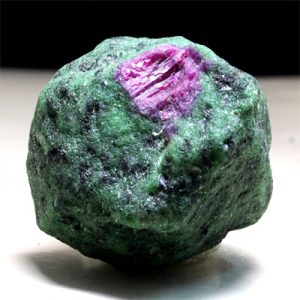Tschermakite
Tschermakite is a fairly common but rarely identified mineral. It often occurs in association with massive green Zoisite and Ruby at the Mundarara Mine, Longido, Mt. Kilimanjaro, Kilimanjaro Region of Tanzania. Black inclusions of Tschermakite are frequently seen in attractive cabochons of bright green Zoisite and pinkish-red Ruby.
Probably widespread. Well-studied material from: Hurry Inlet, Fiskenæsset, Greenland. At Glenelg and Knockormal, Ayrshire, Scotland. From Lake Kutemajärvi, Orivesi, and Perniö, Finland. In France, from Le Viala du Tarn, Aveyron. From the central Bug region, Ukraine.
| Chemical Formula: | Ca2Mg3Al3Fe3+Si6O22(OH)2 |
| Calcium Magnesium Aluminum Iron Silicate Hydroxide | |
| Molecular Weight: | 844.38 gm |
| Composition: | Calcium | 9.49 % | Ca | 13.28 % | CaO |
| Magnesium | 8.64 % | Mg | 14.32 % | MgO | |
| Aluminum | 9.59 % | Al | 18.11 % | Al2O3 | |
| Iron | 6.61 % | Fe | 9.46 % | Fe2O3 | |
| Silicon | 19.96 % | Si | 42.69 % | SiO2 | |
| Hydrogen | 0.24 % | H | 2.13 % | H2O | |
| Oxygen | 45.48 % | O | |||
| 100.00 % | 100.00 % | = TOTAL OXIDE |
| Crystallography: | Monoclinic – Prismatic |
| Crystal Habit: | As prismatic crystals; as reaction rims on other minerals. |
| Twinning: | Simple or multiple twinning || {100}. |
| Cleavage: | Perfect on {110}, intersecting at 56º and 124º; partings on {100}, {001}. |
| Fracture: | Conchoidal |
| Tenacity: | Brittle |
| Moh’s Hardness: | 5.0 – 6.0 |
| Density: | 3.15 (g/cm3) |
| Luminescence: | None |
| Radioactivity: | Not Radioactive |
| Color: | Medium Green to dark Green to Green-Black to Black, Brown (rare). |
| Transparency: | Transparent to Opaque |
| Luster: | Vitreous |
| Refractive Index: | 1.68 – 1.698 Biaxial ( + ) or ( – ) |
| Birefringence: | 0.0180 |
| Dispersion: | Strong; r > v |
| Pleochroism: | Visible to Distinct; in greens and browns |


